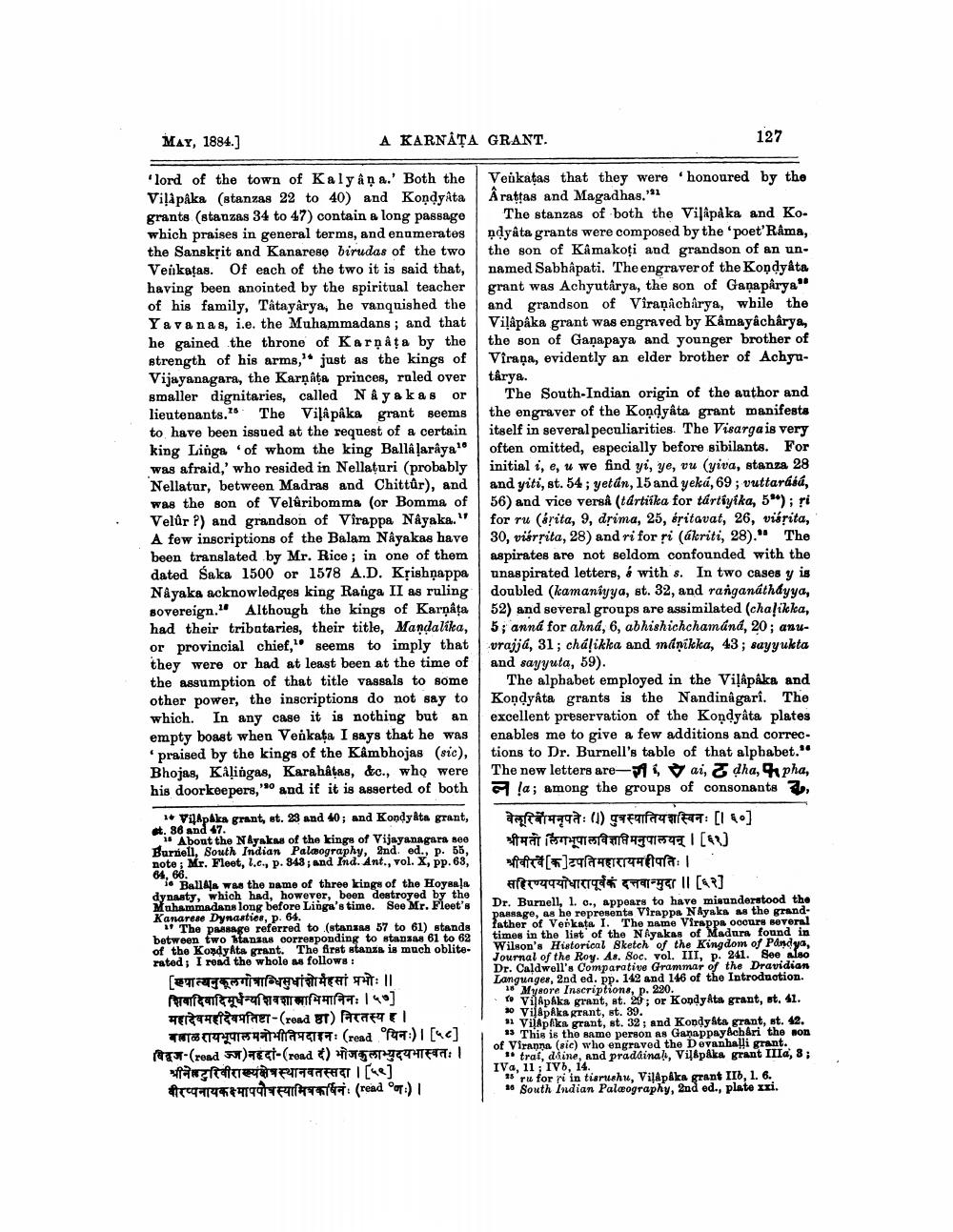________________
A KARNATA GRANT.
MAY, 1884.]
75
'lord of the town of Kalyana.' Both the Vilapaka (stanzas 22 to 40) and Kondyâta grants (stanzas 34 to 47) contain a long passage which praises in general terms, and enumerates the Sanskrit and Kanarese birudas of the two Venkatas. Of each of the two it is said that, having been anointed by the spiritual teacher of his family, Tâtayârya, he vanquished the Yavanas, i.e. the Muhammadans; and that he gained the throne of Karnata by the strength of his arms, just as the kings of Vijayanagara, the Karnata princes, ruled over smaller dignitaries, called Nayakas or lieutenants. The Vilâpâka grant seems to have been issued at the request of a certain king Linga of whom the king Ballâ laraya1o was afraid,' who resided in Nellaturi (probably Nellatur, between Madras and Chittur), and was the son of Velâribomma (or Bomma of Velûr ?) and grandson of Virappa Nayaka." A few inscriptions of the Balam Nayakas have been translated by Mr. Rice; in one of them dated Saka 1500 or 1578 A.D. Krishnappa Nayaka acknowledges king Raiga II as ruling Sovereign. Although the kings of Karnâța had their tributaries, their title, Mandalika, or provincial chief, seems to imply that they were or had at least been at the time of the assumption of that title vassals to some other power, the inscriptions do not say to which. In any case it is nothing but an empty boast when Venkata I says that he was 'praised by the kings of the Kâmbhojas (sic), Bhojas, Kalingas, Karahâtas, &c., who were his doorkeepers," and if it is asserted of both
1 Vilpaka grant, st. 23 and 40; and Kondyâta grant, st. 36 and 47.
1s About the NAyakas of the kings of Vijayanagara see Burnell, South Indian Palæography, 2nd ed., p. 55, note; Mr. Fleet, l.c., p. 343; and Ind. Ant., vol. X, pp. 63, 64, 66.
ie Ballala was the name of three kings of the Hoysala dynasty, which had, however, been destroyed by the Muhammadans long before Linga's time. See Mr. Fleet's Kanarese Dynasties, p. 64.
The passage referred to (stanzas 57 to 61) stands between two stanzas corresponding to stanzas 61 to 62 of the KondyAta grant. The first stanza is much obliterated; I read the whole as follows:
Cargazifamatérkyat si: |||
शिवादिवादिमूर्धन्यशिवशास्त्राभिमानिनः । ५७] महादेव महादेवप्रतिष्टा- (read ष्ठा) निरतस्य ह । बाळ रायभूपाल मनोभीतिप्रदाइन (read 'यिनः) । [ ५८ ] विद्वज- (rend ज्ज) नहदां- (read दं) भोजकुलाभ्युदयभास्वतः । श्रीनेष्टरिवीराख्यक्षेत्र स्थानवतस्सदा । [ ५९ ] वीरप्पनायक क्ष्मापपौत्रस्यामित्रकर्षिनं (read नः) ।
127
Venkatas that they were honoured by the Araṭṭas and Magadhas."
21
The stanzas of both the Vilapaka and Kondyâta grants were composed by the 'poet' Râma, the son of Kâmakoți and grandson of an unnamed Sabhâpati. The engraver of the Kondyâta grant was Achyutârya, the son of Ganapârya" and grandson of Viranacharya, while the Vilâpáka grant was engraved by Kâmayâcharya, the son of Ganapaya and younger brother of Virana, evidently an elder brother of Achyutârya.
The South-Indian origin of the author and the engraver of the Kondyâta grant manifests itself in several peculiarities. The Visarga is very often omitted, especially before sibilants. For initial i, e, u we find yi, ye, vu (yiva, stanza 28 and yiti, st. 54; yetán, 15 and yeká, 69; vuttarású, 56) and vice versa (tártiika for tártiyika, 5"); ri for ru (érita, 9, drima, 25, éritavat, 26, visṛita, 30, visrrita, 28) and ri for ri (ákriti, 28)." The aspirates are not seldom confounded with the unaspirated letters, á with s. In two cases y is doubled (kamaniyya, st. 32, and ranganathayya, 52) and several groups are assimilated (chalikka, 5; anna for ahná, 6, abhishichchamáná, 20; anuvrajjá, 31; chálikka and manikka, 43; sayyukta and sayyuta, 59).
The alphabet employed in the Vilâpaka and Kondyâta grants is the Nandinagari. The excellent preservation of the Kondyâta plates enables me to give a few additions and corrections to Dr. Burnell's table of that alphabet." The new letters are-, ai, dha, pha, la; among the groups of consonants,
Anfänga, (1) greenfierunter. [10] श्रीमती लिंगभूपालविज्ञप्तिमनुपालयन् | [ ६५ ] state [n] पति महारायमहीपतिः ।
सहिरण्यपयोधारापूर्वकं दत्तवान्मुदा ।। [६२]
Dr. Burnell, 1. c., appears to have misunderstood the passage, as he represents Virappa NAyaka as the grandfather of Verkata I. The name Virappa occurs several times in the list of the NAyakas of Madura found in Wilson's Historical Sketch of the Kingdom of Pandya, Journal of the Roy. As. Soc. vol. III, p. 241. See also Dr. Caldwell's Comparative Grammar of the Dravidian Languages, 2nd ed. pp. 142 and 146 of the Introduction. 18 Mysore Inscriptions, p. 220.
to ViApáka grant, st. 29; or Kondy&ta grant, st. 41. 20 Vilapaka grant, st. 39.
31 Vilapfka grant, st. 32; and Kondyâta grant, st. 42. 3 This is the same person as GanappayAchari the son of Viranna (sic) who engraved the Devanhalli grant.
trai, daine, and pradaina!, Vilapaka grant IIIa, 8; IVa, 11; IVb, 14.
15 ru for ri in tisrushu, Vilapaka grant IIb, 1. 6. 16 South Indian Palæography, 2nd ed., plate xxi.




